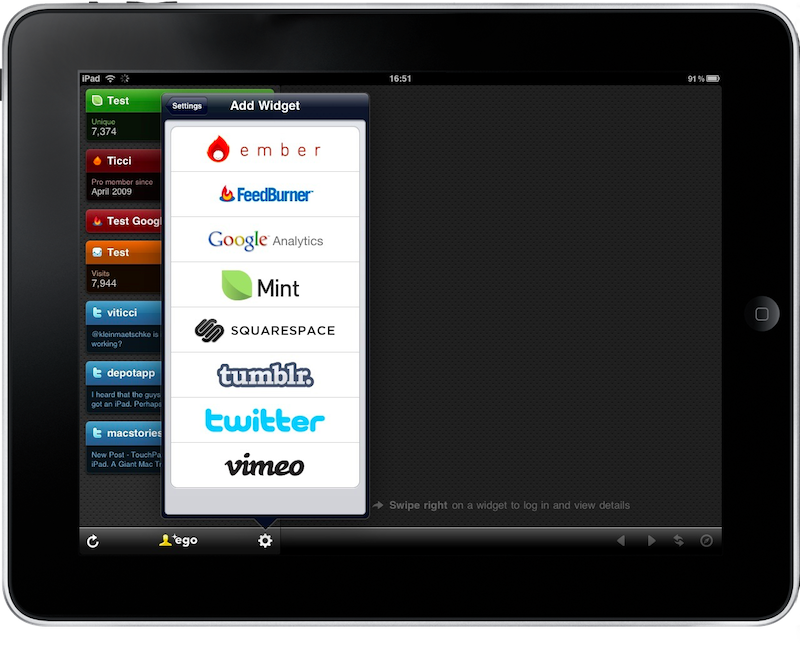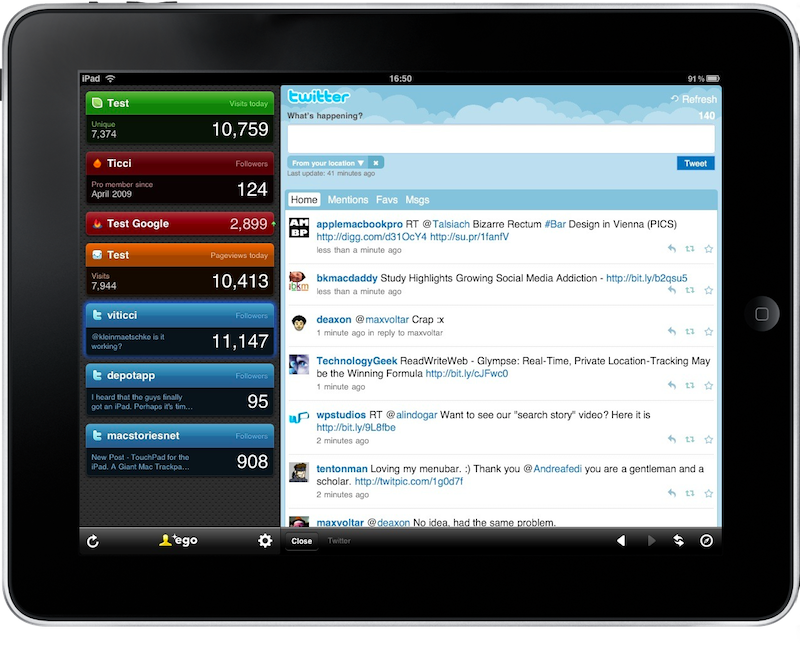You have a blog, and you know that keeping an eye on stats is important. You track visits and unique visitors, but you’ve gotten used to monitor outbound links, referrers and landing pages, because you also know that details are important. You track your Twitter followers, RSS subscribers and Vimeo play counts. Sometimes you wish you could track who follows and unfollows you every day, oh wait - you’ve installed Birdbrain on your iPhone for that. You’re a web analytics junkie. You can’t wait to wake up in the morning to see if someone on the Internet is talking about you, just to see if your latest post has turned out to be that success you expected.
Your most loved iPhone application is Ego. And now you can have it on the iPad as well.
Since I bought my iPad, Ego has been one of the applications I wanted most to land on my new toy. I can safely say that the iPhone version is the application I use most every day, and of course it’s on my home screen first page. Not because I spend a lot of time in it, but because I open it a lot of times during the day. Like every 5 minutes. So as you can guess, Ego was definitely the iPad app I was looking forward to.
Last night, while I was writing some posts for MacStories, I fired up Twitterrific and found out that Garrett Murray finally released Ego on the iPad App Store, and the night couldn’t have turned out to be better. The web analytics junkie in me told me I needed to go download it and install it. I did. And I’m telling you, Ego for iPad is the application you must have if you check your Internet numbers on a daily, maybe hourly, basis.
For those who don’t know what I’m talking about, Ego is a simple and well designed app that allows you to configure multiple widgets for services like Mint, Twitter and Google Analytics in order to keep track of your stats. You can configure the Feedeburner widget to see how many RSS subscribers your blog has. You can create multiple Twitter widgets for all the accounts you have. The system is simple: you create these widgets, you open the app and stats are refreshed. You’re important, and Ego knows that you care about stats. It’s an app meant for those people who live on the Internet and care about numbers. Most of all, Ego sports some great pixels that make the action of checking these numbers something beautiful and pleasant. You’ll slowly come to the point where you’ll want to open Ego just to take a look at the color of the widgets and the grid background. If you used the app on the iPhone, I think you can understand.
Cool thing is, the iPad version is not a simple porting of the iPhone one with some extra pixels. Actually there are a lot of extra pixels, but it’s the idea that Garrett had that matters. If Ego for iPhone was meant to get a glimpse of what’s going on, Ego for iPad lets understand what’s going on. While on the iPhone the only thing you can do is to refresh and see the updated stats, now you can understand those quick stats and get the details about them. Basically, the iPad version takes advantage of the bigger screen and allows you to log into the web services you’ve configured a widget for, to see detailed stats and such. You can have a Google Analytics widget and Google Analytics itself on the right. Have a Mint widget and see Mint on the left. It’s a web analytics junkie’s dream come true: a more powerful and in-depth Ego, that maintains the same feeling it had before.
Widgets sit in a left sidebar, but Ego doesn’t currently support portrait view mode to allocate the sidebar in a popover. I’m fine with the landscape, but perhaps Garrett will add portrait support in a future update. Adding widgets is easy: just tap on the gear icon and choose one from the list of available services. It’s been very nice to see support for Tumblr stats, which should come in the iPhone version as well soon.
To open the web view for a widget you have to swipe over it. I found this implementation clever and intuitive, the web view fast and “just right”. I think that while at first you might be disappointed (“it’s the iPhone app with a web view!”), as you understand the concept behind the it, Ego for iPad will grow on you. It’s grown on me in a matter of a few hours, and so it will for you. Ego for iPad is bigger, and so should be the possibility to check your stats. And if you consider that these services come with powerful and well known web apps, you realize how much this version of Ego could become the favorite app of many people like me. You can spend hours messing in Google Analytics, or just tweet from the Twitter iPad web view. Maybe you should also go discover some neat images in Ember. Once you get the hang of it, you won’t have any doubt anymore.
One could argue that Ego for iPad is a porting with a few added features and that it’s not worth your money again. I think that you’re not the right user for this application then. If you loved Ego for iPhone and when you bought an iPad the first thing you did was creating a webclip for Mint, Ego is a must have. If you haven’t used Ego before and you’re a web anakytics junkie, this one is aimed at you. Just go download it and you won’t regret it.




